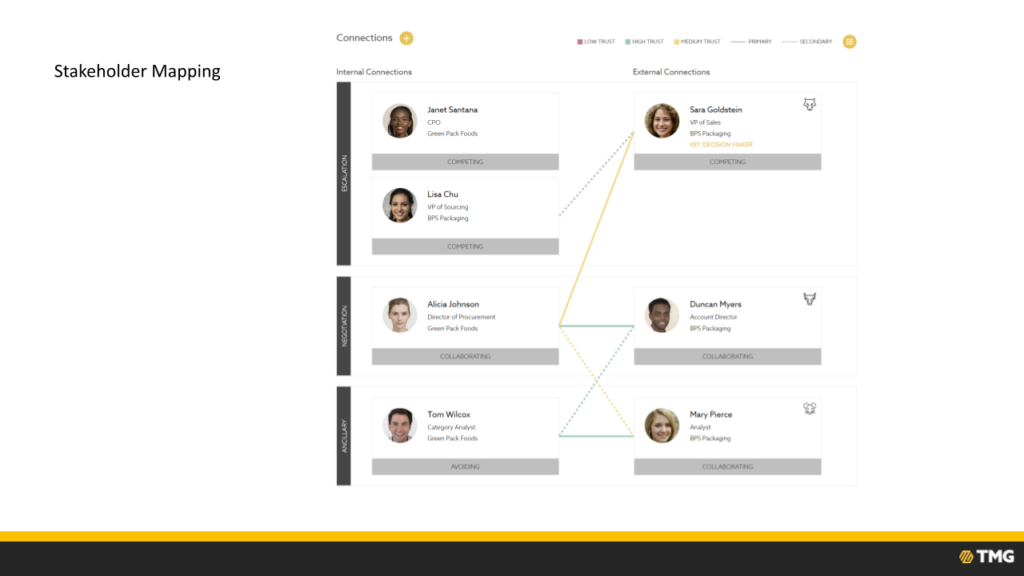Going into a negotiation without the appropriate information on stakeholders can be frustrating at best and disastrous at worst.
Knowing where to prioritize your efforts and how to effectively engage stakeholders is key in any negotiation. But it’s not easy if you don’t have the right tools.
Stakeholder maps are essential tools to help guide negotiations and bring them to desired conclusions.
In this guide, we’ll take a detailed look at what stakeholder mapping involves, why it’s important, and how you can use stakeholder maps to benefit every party in a negotiation.
Table of Contents
- What Is Meant by Stakeholder Mapping?
- Questions To Ask Yourself When Creating a Stakeholder Map
- Identifying Your Internal and External Stakeholders and Why This Step Is Important for Negotiations
- What Are the Basic Components of a Stakeholder Map?
- What Are the Advantages of Stakeholder Mapping for Negotiations?
- Let The Maker Group Show You How Stakeholder Mapping Can Improve Your Negotiation Strategy
What Is Meant by Stakeholder Mapping?
A stakeholder map is a way to visualize stakeholders to identify their influence and interest in a project.
Stakeholders are organizations or people who have a vested interest in a project or business. Stakeholders can be:
- Internal – Those inside the company or project who are concerned about or involved in the negotiation; or
- External – Those in authority that you are negotiating with or who are affected by the negotiation
When negotiating, stakeholder mapping is important internally to get alignment and externally, to understand the motivations and authority levels of those involved in the negotiation.
Preparing for project consultations is essential, and stakeholder mapping helps you be able to evaluate things from all angles.
With a better understanding of what authority levels are involved, you’ll know how they can help or hamper a project.
Whether you’re preparing for a negotiation or need help with an ongoing negotiation, The Maker Group is here for you. With years of experience, our consultants know what you need and how to help you achieve your objectives.
Why Is Stakeholder Mapping So Important?
Small and large-scale projects alike will involve various stakeholders. And with numerous stakeholders come numerous:
- Priorities
- Objectives; and
- Incentives
Knowing these aspects about the different stakeholders will assist in creating strategies, outlining action plans, and communicating them in the best way possible to achieve the desired outcome.
Specifically, stakeholder mapping is key to:
- Avoid conflict
- Inform decision-making
- Reach alignment on objectives
- Understand boundaries
- Establish a communication plan
- Communicate with each stakeholder appropriately
- Visualize and achieve success
- Gain insight from the stakeholders to inform planning and strategy
- Know the stakeholders’ desires
- Manage expectations
- Involve the right stakeholders and the appropriate times
- Understand the incentives of the different stakeholders
Questions To Ask Yourself When Creating a Stakeholder Map
To make an effective stakeholder map, you need the best information.
Asking the following questions can aid in creating a map that speeds progress and aligns with the project goals:
- Who are your stakeholders? Consider both internal and external stakeholders who may be:
- Customers
- Suppliers
- Project Managers
- CEOs
- Designers; or
- Developers
- How influential and powerful are they? Determine who the key leaders are and how the stakeholders compare with each other.
- Are individual stakeholders supportive or oppositional to your project? Knowing this can help reduce conflict and ensure cooperation across the board.
- Are your stakeholders easily influenced by others’ opinions? Determine which stakeholders are unwavering and which ones are easily swayed.
- What issues are most important to them? Which ones are less important? Knowing this can help to include details in the project that show stakeholders you’re listening to their concerns.
- Is there a network of connections with your stakeholders? Identify existing connections and assess the strength and type of those connections.
Identifying Your Internal and External Stakeholders and Why This Step Is Important for Negotiations
Because they have a vested interest or influence in your project, identifying both internal and external stakeholders is key to setting priorities, strategizing, and implementing the details of the project.
Below we’ll take a look at both types of stakeholders, how to identify them, and why it’s important to do so.
Internal Stakeholders
Internal stakeholders are those working with the project in some way by …
- Designing
- Advertising
- Delivering; or
- Participating in other ways
… and may include:
- Project sponsors
- CEOs
- Project managers
- Employees
- Development personnel
- Advisors
- Finance and/or marketing departments
Determining who the internal stakeholders are is important to align objectives and understand authority levels. Though it can be difficult, the payoff will be worthwhile by having everyone on the same page and working toward the same goal.
When attempting to align objectives, as a team, you’ll want to answer questions like:
- What are we trying to accomplish?
- What are the guardrails that define our boundaries?
- What are our priorities?
- What are the incentive structures we need to consider?
As you go up the authority ladder, incentive structures can change. Different incentives will also mean different priorities for those in authority. Understanding incentive structures and knowing how to work with stakeholders with differing incentives is crucial to avoid conflict.
For example, at the bottom of the ladder, volume and sales growth are usually incentives, so setting prices low may be a priority for that stakeholder. On the other hand, a boss higher in the authority structure may have a profitability metric worked into their incentive package. Their priority won’t be pushing volume but will be considering volume and price to ensure a healthy profit.
External Stakeholders
External stakeholders are those on the outside of the project who you may be negotiating with, who may be affected by the project, or who may influence the outcome. Creating a map of external stakeholders will be most helpful when you understand authority structures that include:
- The party you are negotiating with
- The leader above them; and
- The ultimate decision maker
And don’t forget about those below these leaders. They can provide helpful information, and when information comes from within, it can be better received.
The best way to effectively map external stakeholders is to do some work on the front end to gather some vital information about them, including:
- What motivates them
- Their personality types
- Their authority levels
- Different roles in the negotiation; and
- What influences them
Knowing these details equips you to astutely work toward the ultimate outcome.
Some players who may be considered external stakeholders include:
- Customers
- Government and local authorities
- Sponsors
- Suppliers
- Lenders
- Clients
- Influencers and action groups

What Are the Basic Components of a Stakeholder Map?
The basic components of a stakeholder map will change depending on the style of map you choose and the criteria used to classify each stakeholder. Each type of stakeholder map is created for a specific purpose but may come with various limitations.
To choose the map that works best for your purposes, it’s important to identify your priorities regarding stakeholders, which may include:
- Frequency and intensity of contact
- Communication and engagement
- Flexibility
- Grouping shareholders
- Level of stakeholder monitoring
Some common stakeholder maps include:
- Concentric circle maps may include internal stakeholders in the inner circle and external stakeholders in the outer circle. Or maybe you’d use this type of map to include the business context in the inner circle and the financial context in the outer one.
- A salience model is a type of Venn diagram that compares categories for prioritization and how they overlap. You may use this type of stakeholder map to compare stakeholder levels of legitimacy, power, and urgency.
- Relationship maps are used to see how stakeholders are linked and may also be used to also compare their level of involvement or degree of influence.
- Spreadsheets can also be useful to include basic information about stakeholders and to look at a variety of attributes side by side.
- Quadrant maps are the most common type of stakeholder maps. With these types of maps, the x and y axis represent particular measurements (i.e., knowledge/attitude, power/predictability, or influence/interest). The four quadrants measure each stakeholder based on the 2 measurements.
To better understand, let’s look at the implications of a quadrant map measuring influence and interest. The four quadrants would be classified as:
- Low influence, low interest (bottom left quadrant)
- Low influence, high interest (top left quadrant)
- High influence, low interest (bottom right quadrant)
- High influence, high interest (top right quadrant)
After placing stakeholders in one of the four quadrants, you can then determine the appropriate action to take with each one.
Quadrant 1: Monitor
Quadrant 1 stakeholders are ones with both low interest and influence. These stakeholders are likely ones that don’t hold much power in decision-making. The best way to engage these stakeholders is to monitor them to keep them engaged and interested over time.
Quadrant 2: Keep Informed
Quadrant 2 stakeholders are those with low influence but high interest. They are highly interested in the project but don’t have much influence on the direction of the project. Customers may fit in this quadrant. It’s important to keep these stakeholders informed to keep their interest and benefit from their feedback.
Quadrant 3: Keep Satisfied
Stakeholders in this section are those who have high influence but low interest in the project. More stakeholders may fit in this quadrant and tend to be those who are owners or investors. You’ll want to keep these stakeholders satisfied and find a way to incorporate their goals into the goals of the project.
Quadrant 4: Manage Closely
Stakeholders in this quadrant have both a high level of interest and influence and will be the most important stakeholders for your project. Because they will be influential in decision-making, you’ll want to engage them closely with frequent contact and involvement.
What Are the Advantages of Stakeholder Mapping for Negotiations?
Stakeholder maps can be very useful for all sorts of ventures, including:
- Launching a new product
- Initiating new marketing strategies
- Conducting market research
- And more
The benefits of stakeholder mapping are also numerous. Let’s take a look at the four of the top stakeholder mapping benefits.
Prioritize Effectively
Identifying which stakeholders have a high level of influence and power allows you to position your negotiation in a way that appeals to them the most. Without a stakeholder map, you may flounder and waste resources because you don’t know how to gauge engagement with individual stakeholders.
Create Alignment
Stakeholder mapping is an important tool to bring a team together and make sure that everyone is on the same page and working toward the same goal. Having this in mind allows you to create transparency and clear communication with the team.
Create an Engagement Strategy
The quadrant stakeholder map mentioned above is an excellent example of how stakeholder mapping can aid in creating and implementing an engagement strategy. Without one, your engagement with stakeholders may turn into an impromptu situation without structure, efficiency, or effectiveness.
Mitigate Risks
Without a stakeholder map, you may miss important information regarding potential conflicts and priority issues. With the insight that comes from stakeholder mapping, you’ll be better equipped to foresee potential issues and be proactive in devising solutions. In the end, you’ll be able to create a strategy that benefits both you and your stakeholders.
Let The Maker Group Show You How Stakeholder Mapping Can Improve Your Negotiation Strategy
If you’re inexperienced with negotiating or your negotiation results have not been successful, The Maker Group has the experience to help you make your negotiations as fruitful as possible.
Our team of consultants has years of experience working with some of the largest companies in the world, including:
- Mohawk
- Panasonic
- Chobani
- Red Bull
- And more
We know the challenges you face, and we are poised and able to help.
And when it comes to stakeholder mapping, our unique approach and tools categorize stakeholders in …
- Escalation
- Negotiation; and
- Ancillary
… roles while also displaying fields to show:
- Job titles
- Personality types
- Decision-making levels, and
- Internal and external connections
Our tailored approach helps to keep the achievement of our clients’ objectives as the number one priority.
And unlike other negotiation consultant firms, The Maker Group walks with our clients from the beginning of the negotiation to its execution to ensure satisfactory completion.
To learn more or book a consultation, contact The Maker Group today.


